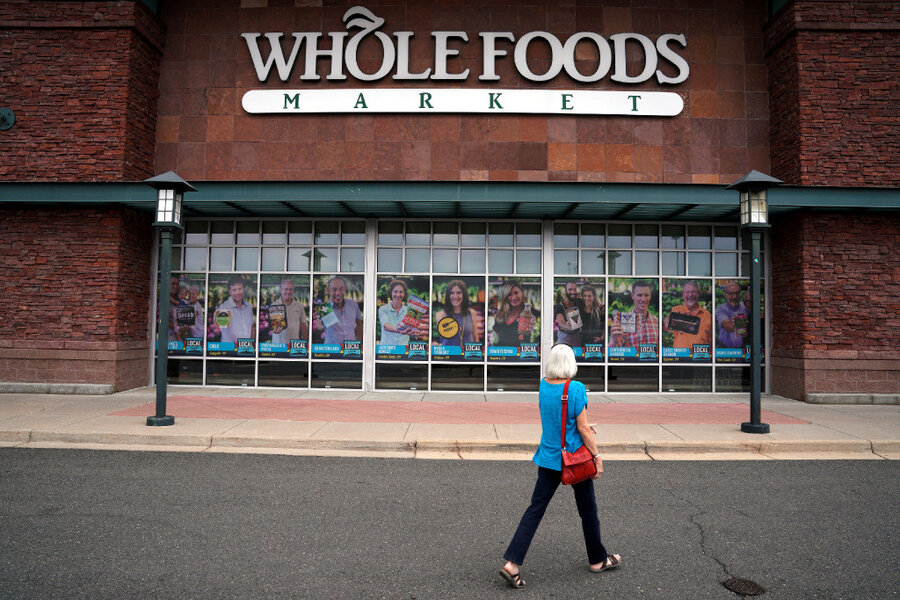Amazon's announcement of Whole Foods price cuts sends shares of rival grocers tumbling
Loading...
| NEW YORK
Amazon said it will cut prices on a range of popular goods as it completes its acquisition of Whole Foods, sending shares of rival grocers tumbling on fears that brutal market share battles will intensify.
Amazon’s $13.7 billion purchase of Whole Foods, which will be completed on Monday, has been hanging over a brick-and-mortar retail sector unsure of how to respond to the world’s biggest online retailer.
Shares of Kroger, the biggest United States supermarket operator, closed down 8 percent, while Wal-Mart, the biggest US food seller, closed down 2 percent.
Amazon also said it will start selling Whole Foods brand products on its website, a move that sent down shares of packaged food sellers, including Kellogg.
The S&P 500 Food Retail index closed down almost 5 percent as more than $10 billion was wiped off the market value of big food sellers.
Amazon said members of its $99-per-year Prime shopping club would eventually be rolled into Whole Foods’ customer rewards program and be eligible for special offers and discounts.
“There was never any doubt that Amazon would lower prices, and even offer further discounts in-store to Prime members,” said Baird Equity Research analyst Colin Sebastian.
Land grab
Amazon said that starting on Monday, it will cut prices on organic grocery staples such as bananas, avocados, brown eggs, farmed salmon and tilapia, baby kale and lettuce, some apples, butter, and other products.
“It does not look like they will go kamikaze on pricing,” said Roger Davidson, president of consulting firm Oakton Advisory Group and a former retail executive. “They will lower prices on consequential items to drive traffic and sales but not do a whole store price reduction which could really damage gross margin and potentially wipe out operating margin.”
Lowering prices could stem defections by price-sensitive Whole Foods shoppers and help the grocer shed its “Whole Paycheck” reputation for high prices that are generally 15 to 25 percent above rivals. It could also bring in new consumers who can then be urged to shop for food and other products online.
“It’s ultimately a nice land grab,” said Bill Bishop of retail consultancy Brick Meets Click, and a way to get customers “thinking about buying healthy food from Amazon.”
Fat profits
The planned price cuts would have been a tough sell to Whole Foods’ investors, who had grown used to fat profits from the upscale chain, but are more in line with Amazon’s broader strategy of sacrificing short-term profit for long-term market dominance.
“Amazon is more focused on driving volume and improving service at the expense of profit margins,” said Mr. Sebastian. “Long-term, this strategy works because the absolute profit dollars can still be significant.”
Amazon’s willingness to take lower profit margins ups the ante in the increasingly costly grocery price war.
“In some cases, grocery retailers have had to invest between $500 million to $1 billion in order to reduce prices to a level that retained customers and resulted in a net increase in customers,” said Brittain Ladd, who until earlier this year was a senior manager working to globally roll out AmazonFresh, Amazon’s grocery delivery service.
Adding Whole Foods benefits should help Amazon attract more shoppers to its successful Prime scheme, which features two-day shipping for eligible purchases and unlimited streaming of movies and TV shows. Amazon has more than 60 million Prime members, according to analyst estimates.
Whole Foods has rolled out a loyalty program at its smaller, lower-priced 365 by Whole Foods chain, which offers members 10 percent off more than 100 items in the stores. The program is still being tested in the main Whole Foods chain.
Beyond that, some Whole Foods stores will get Amazon Lockers, where customers can receive online orders and make returns. John Mackey will remain chief executive of Whole Foods and the company will operate as a subsidiary and continue to be headquartered in Austin, Texas, the companies said on Thursday.
This story was reported by Reuters.







